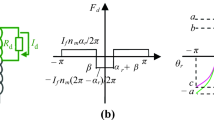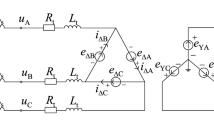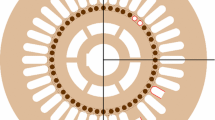Abstract
In this manuscript the novel methodology of quick and accurate calculation of the rotor and stator currents during a three-phase sudden short-circuit is presented. The proposed approach consists of two parts. First, the detailed finite element model is developed. It accounts for stator core and winding, rotor yoke and winding, damper winding and conductive rotor surface. Second, the revised analytical formulation of the existing approaches to evaluate transient field current behavior during a three-phase sudden short-circuit is presented. Four phenomenological coefficients are introduced for proper representation of the field winding current. The developed methodology is feasible for solid and laminated rotors, with and without damper bars. It is demonstrated that there is good agreement between the results of our theoretical approach and the factory tests.
Zusammenfassung
Dieser Beitrag stellt eine mögliche Methodik vor, welche die Läufer- und Ständerströme im dreiphasigen Stoßkurzschluss von Turbogeneratoren großer Leistung bestimmt. Als erstes wird ein Finite-Elemente-Modell präsentiert, welches das Ständerblechpaket, die Ständerwicklung, das Rotorjoch, die Rotorwicklung und den Dämpferkreis abbildet. Im nächsten Schritt wird eine analytische Gleichung vorgestellt, die den Rotorstromverlauf mittels vier Koeffizienten beschreibt. Die analytische Gleichung kann die zeitveränderlichen Ströme im dreiphasigen Stoßkurzschluss für massive und geblechte Rotoren sowie mit und ohne Dämpferkreis beschreiben. Die analytische Gleichung wurde von den Ergebnissen des Finite-Elemente-Modells abgeleitet. Das Finite-Elemente-Modell und die analytische Beschreibung zeigen gute Übereinstimmung mit den im Prüffeldprobelauf gemessenen Strömen.


























Similar content being viewed by others
Abbreviations
- 3P-SSC:
-
Three-phase sudden short-circuit
- \(f\) :
-
Frequency
- FEA:
-
Finite element analysis
- \(i_{f}\) :
-
Field current
- \(i_{s}\) :
-
Stator current
- \(K_{0}, K_{1}, K_{2}, K_{3}\) :
-
Coefficients for analytical description of rotor currents
- \(l_{S}\) :
-
Length of stator end winding
- \(L_{m}\) :
-
Mutual damper wedge and self-inductance
- \(L_{S}\), \(X_{S}\) :
-
Stator winding leakage inductance/reactance
- \(R_{1}, R_{2}, \ldots\) :
-
Wedge to retaining ring contact resistors
- \(R_{a}, R_{b}, \ldots\) :
-
Axial wedge resistance
- \(R_{K}\) :
-
Damper winding contact resistance
- \(R_{A}\) :
-
Armature resistance
- \(R_{f}\) :
-
Field winding resistance
- \(T_{a}\) :
-
Armature time constant
- \(T_{\mathit{dO}}\) :
-
Transient time constant when rotor surface is conductive
- \(T_{d}^{''}\) :
-
Sub-transient time constant
- \(T_{d} '\) :
-
Transient time constant
- \(u_{\mathit{fd}}\) :
-
Field winding voltage
- \(U_{L ( a )}\) :
-
RMS stator voltage in phase (a)
- \(X_{d}\) :
-
Synchronous reactance
- \(X_{d} '\) :
-
Transient reactance in d-axis
- \(X_{d}^{''}\) :
-
Sub-transient in d-axis direction
- \(X_{q}^{''}\) :
-
Sub-transient reactance in q-axis direction
- \(X_{H}\) :
-
2D Finite element straight part main reactance (excluding end zone leakage, but include stator slot leakage)
- \(X_{f}\) :
-
2D Finite element rotor reactance (excluding end zone leakage)
- \(\lambda_{S}\) :
-
Permeance factor for end winding leakage reactance
- \(\vartheta_{0}\) :
-
Phase angle (0°, \(+120\)°, −120°)
- \(w\) :
-
Number of stator winding turns in series for voltage induction
- \(\omega =2\pi f\) :
-
Angular frequency
References
Park, R. H. (1929): Two reaction theory of synchronous machines. AIEE Trans., 48, 716–730.
Kilgore, L. (1931): The calculation of synchronous machine constants-reactances and time constants affecting transient characteristics. AIEE Trans., 50, 1201–1213.
Concordia, C. (1951): Theory and performance of synchronous machines. New York: Wiley.
Müller, G., Vogt, K., Ponick, B. (2008): Berechnung elektrischer Maschinen. Weinheim: Wiley–VCH.
Binder, A. (2012): Elektrische Maschinen und Antriebe. Berlin: Springer.
Liwschitz, M. (1934): Die elektrischen Maschinen: Berechnung und Bemessung (Vol. 3). Leipzig: Teubner.
Bolte, E. (2012): Elektrische Maschinen. Berlin: Springer.
Richter, R. (1963): Elektrische Maschinen: Synchronmaschinen und Einankerumformer (Vols. 2–5, 3th ed.).
Canay, M. (1968): Ersatzschemata der Synchronmaschine sowie Vorausbestimmung der Kenngrößen mit Beispielen. Dissertation, Ecole Polytechnique de l’Université de Lausanne, Lausanne
Wamkeue, R., Elkadr, N. E. E., Kamwa, I., Chacha, M. (2000): Unbalanced transient-based finite-element modeling of large generators. Electr. Power Syst. Res., 56, 205–210.
Wamkeue, R., Kamwa, I., Chacha, M. (2003): Line-to-line short-circuit-based finite-element performance and parameter prediction of large hydrogen- generators. IEEE Trans. Energy Convers., 18(3), 370–378.
Ramirez, C., Tu Xuam, M., Schafer, D., Stephan, C. (2000): Synchronous machines parameters determination using finite element method. In International conference on electrical machines, ICEM 2000, Espoo Finland, 28–30 Aug., ref. 1130.
Schlemmer, E., Ofner, G. (2008): Finite-element investigations of the transient behavior of salient-pole synchronous machines with different damper end connections. In Int. conf. electric machines, ICEM, Vilamoura, Portugal, 6–9 Sep., Paper PD.3.13.
Traxler-Samek, G. (2006): Computation of forces and stresses in the winding overhang of large hydrogenerators at faulty conditions. In International conference on electrical machines, ICEM 2006.
Tessarolo, A., Luise, F. (2008): An analytical-numeric method for stator end-coil leakage inductance computation in multi-phase electric machines. In Conf. rec. IEEE IAS annu. meeting, Edmonton, Canada, 5–9 Oct., Paper 79.
Göbel, M. (2014): Betrachtung und Berechnung magnetischer Felder im Wickelkopf 2-polier Turbogeneratoren mit Hilfe von Ansys Maxwell.
Ban, D., Zarko, D., Mandic, I. (2005): Turbogenerator end-winding leakage inductance calculation using a 3-D analytical approach based on the solution of Newmann integrals. IEEE Trans. Energy Convers., 20(1), 90–105.
Rotating electrical machines, part 4: Methods for determining synchronous machine quantities from tests, IEC Std. 34-4 (1995).
Ranlof, M., Lundin, U. (2010): The rotating field method applied to damper loss calculation in large hydrogenerators. In Int. conf. electric machines, ICEM, Rome, Italy, 6–9 Sep., Paper RF-001317.
Mukherjee, K., Iyer, K., Lu, X., Kar, N. (2013): A novel and fundamental approach toward field and damper circuit parameter determination of synchronous machine. IEEE Trans. Ind. Appl., 49(5), 2097–2105.
Zhao, Z., Zheng, F., Gao, J., Xu, L. (1995): A dynamic on-line parameter identification and full-scale system experimental verification for large synchronous machines. IEEE Trans. Energy Convers., 10(3), 392–398.
Kyriakides, E., Heydt, G., Vittal, V. (2004): On-line estimation of synchronous generator parameters using a damper current observer and a graphic user interface. IEEE Trans. Energy Convers., 19(3), 499–507.
Bassi, C., Giulivo, D., Tessarolo, A. (2010): Transient finite-element analysis and testing of a salient-pole synchronous generator with different damper winding design solutions. In Int. conf. electric machines, ICEM, Rome, Italy, 6–9 Sep., Paper RF-008079.
Acknowledgement
The author would like to thank ANSYS-Germany for sponsoring ANSYS EM Licenses for the work presented in this document. Also, the advice of Prof. Dr. Ponick of the Institute for Drive Systems and Power Electronics (IAL) Hanover has been influential in guiding this work.
Author information
Authors and Affiliations
Corresponding author
Rights and permissions
About this article
Cite this article
Hackbart, M. Novel approach to calculate electrical currents in stator-, field- and damper-windings at three-phase sudden short-circuit for large synchronous generators. Elektrotech. Inftech. 133, 112–120 (2016). https://doi.org/10.1007/s00502-016-0389-7
Received:
Accepted:
Published:
Issue Date:
DOI: https://doi.org/10.1007/s00502-016-0389-7




